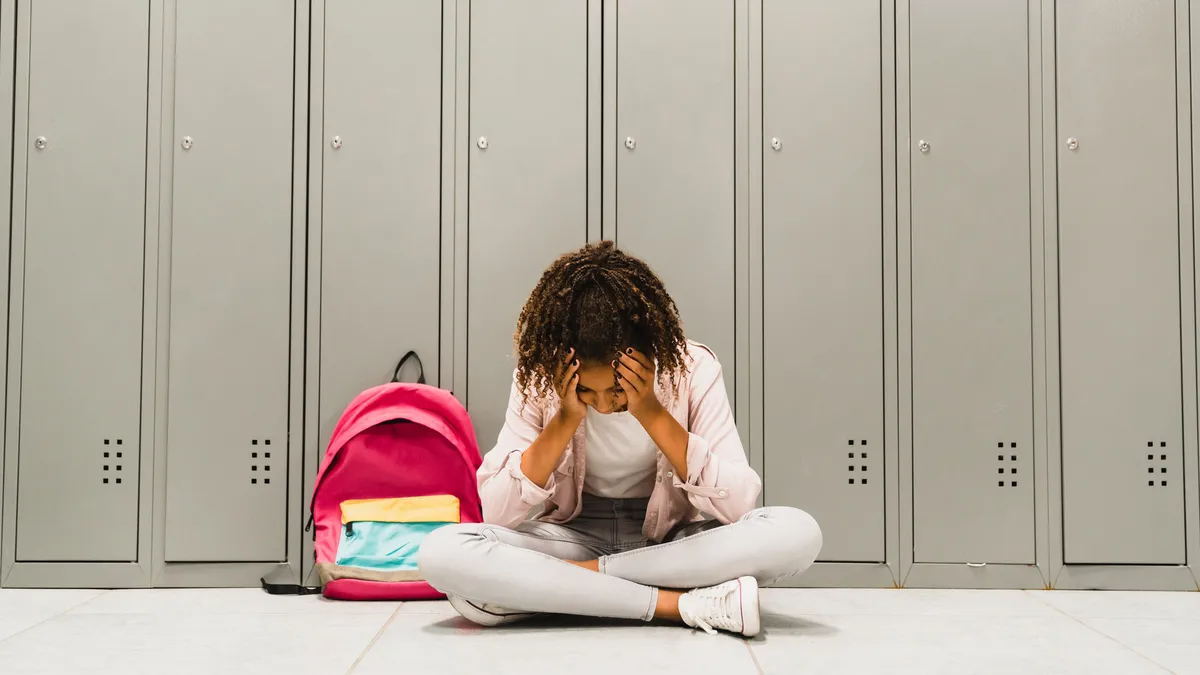Researchers have long known poor mental health negatively affects academic achievement, and the COVID-19 pandemic has put a spotlight on how schools can help address the issue.
“In the past, addressing students’ mental health concerns was considered separate from addressing their academic achievement,” said Laurie McGarry Klose, an educational consultant and immediate past president of National Association of School Psychologists. “What educators and non-mental health professionals who work in schools are beginning to understand is that, unless students feel OK and have reasonable stability in their mental health, unless they have that foundation, they are not available for learning.”
Just over half of U.S. public schools offered mental health assessments for students — and even fewer offered treatment — during the 2019-20 school year, the Pew Research Center reported in August. Schools cited barriers such as inadequate funding and access to licensed mental health professionals, school policies, potential legal issues, lack of community support, reaction from parents and reluctance to label students.
Alongside partnering with nonprofits that offer tailored programs, experts recommend the following nine foundational approaches to caring for students’ mental health in schools.
Start with prevention and staff development
Schools should ensure psychoeducation around mental health is a priority in terms of the professional development of staff, said Janine Domingues, senior director of professional training of school and community programs at the nonprofit Child Mind Institute, which provides prevention, intervention and professional training programs for K-12 schools.
For example, educators can learn about indicators of poor mental health among students and know what signs and symptoms to look for based on their age and developmental differences, she said.
Schools should think in terms of applying prevention models, starting at a young age, McGarry Klose said. “I’d say about 10% of students are going to have experiences that result in significant development and mental health needs,” she said. “For the other 90%, we have to be thinking about how we bolster them, so when they encounter adversity, when they encounter a trauma, they are able to successfully resolve those things and continue on a path of mental health.”
Understand your student population
Schools must take a close look at the sociodemographic characteristics and needs of their student population to provide culturally responsible mental health services, said Lauren Smith, clinical director of culturally responsible programming for Trails to Wellness, which provides programs focused on mental health strategies for school settings.
“A lot of evidence-based mental health practices have been developed without communities of color in mind, as well as gender and sexual minorities,” Smith said. “It’s critical to see who your students are and have some adaptations around that.”
While research has found positive mental health outcomes can happen without a racial match between students and mental health practitioners, Smith said, such a match helps students form positive relationships with adults — particularly for youths who need to develop social and emotional skills.
Create connection with students
Research shows the best way for schools to support students and prevent mental health issues among students is through safe, supportive and connective relationships, said B. Grace Bullock, director of mental and behavioral health for the Oregon Department of Education.
The department launched a Care & Connection campaign in summer 2021 that outlines a range of strategies schools can use to achieve a connection. They include, for example:
- Greeting students individually each morning.
- Asking students how they are feeling every day.
- Creating time for students and teachers to get to know each other.
- Allowing students to express themselves through different mediums, such as art, music, dance, creative writing and more.
The last item in particular gives students an outlet to express themselves in ways that feel genuine to them, which in turn fosters feelings of empowerment and self-efficacy, Bullock said.
Integrate mental health into curricula
It’s essential to normalize conversations about mental health as part of everyday education so children can learn it’s normal to experience a range of emotions, including difficult ones like sadness and anxiety, Smith said.
The Child Mind Institute works with school staff to integrate mental health “lessons” within school curricula, Domingues said. That includes discussing topics in the classroom such as understanding feelings and managing intense emotions, and teaching coping strategies like mindfulness and relaxation.
Students who are more at risk, such as those who experience depression and anxiety symptoms, benefit from small group discussions with a sharpened focus on skills building, Domingues said.
Students with a mental health diagnosis, or who are teetering on the edge of that, can benefit from more intensive services, including one-on-one counseling, she said, while the group-based model is conducive to creating connection among students — which is particularly effective around shared trauma experiences.
“There is something really magical about that,” she said.
Use helpful technology
Smartphone apps can help students learn about things like mindfulness and relaxation, monitor their own mood, and be reminded of skills they can use during stressful times, Domingues said.
Technology is a great tool to provide mental health education to caregivers, who are more likely to attend workshops and sessions when they are offered virtually, she added. The Child Mind Institute also uses videos to offer a free skills-building curriculum that caregivers and educators can use to teach children about mental health and coping skills, a project developed in partnership with the state of California.
Make cultural context a priority
On a basic level, mental health services and all related materials should be available in the languages students speak at home, the experts said.
In a pinch, schools can use translation services, but that can be problematic due to confidentiality issues and difficulties in ensuring translations retain the “true meaning” of sensitive topics around mental health, McGarry Klose said.
Domingues added that it’s not about simply translating materials, but engaging experts to create materials that have the appropriate cultural context in different languages. “Every culture has a way of describing, naming and talking about certain things, and we really want to create safe spaces around that,” she said.
Acknowledge the effects of COVID-19
Educators should take into account the effects of the COVID-19 pandemic as part of their focus on mental health, experts said. Smith suggested explicitly acknowledging this with staff and students, with a focus on teaching coping skills and encouraging self-care — including giving everyone the space to engage in that when needed.
Bullock said it’s important to be careful around the language used to describe the effects of the pandemic. It’s widely known that groups of people — such as communities of color, service workers, unhoused individuals and people lacking financial resources — were disproportionately affected in traumatic ways, she said.
For others, the pandemic was stressful but not necessarily traumatic, Bullock said. “Stress is not equivalent to trauma, and it’s important we recognize that,” she said, adding she advocates focusing on positives like resiliency and coping skills for students and families.
Provide suicide prevention training
Schools should provide suicide education and training on risk assessment and prevention to everyone in the building, from staff to students, as well as students’ families, Smith said.
Organizations like the National Alliance on Mental Illness, Nationwide Children’s Hospital and the American Foundation for Suicide Prevention agree there is a myth that talking about suicide causes people to have suicidal ideation. Instead, thoughtful discussions about suicide can help prevent its occurrence by encouraging people to share their feelings, experts say.
Smith said she encourages educators to engage in such discussions with a focus on providing safe spaces for students to share their feelings while also working on teaching them tools and coping skills to manage their emotions.
Don’t forget mental health for adults
Schools must recognize the importance of encouraging good mental health among staff members and should foster a supportive culture in this regard, McGarry Klose said. This includes ensuring all staff members have access to mental health services, particularly if they are having trouble coping or have underlying or previously unknown mental health needs.
“It begins with acknowledging mental health and not shaming people for being anxious or depressed or stressed,” she said. “It’s about acknowledging all this is a perfectly reasonable reaction to ‘the mess,’ if you will.”




















